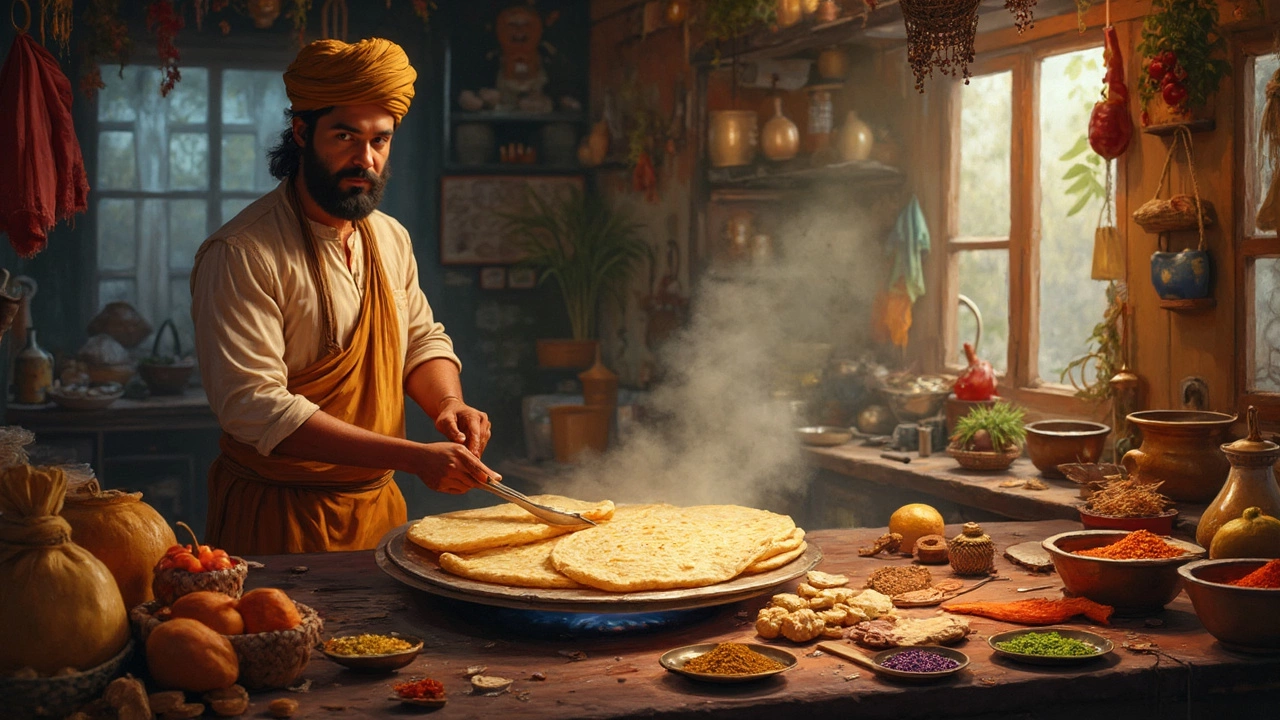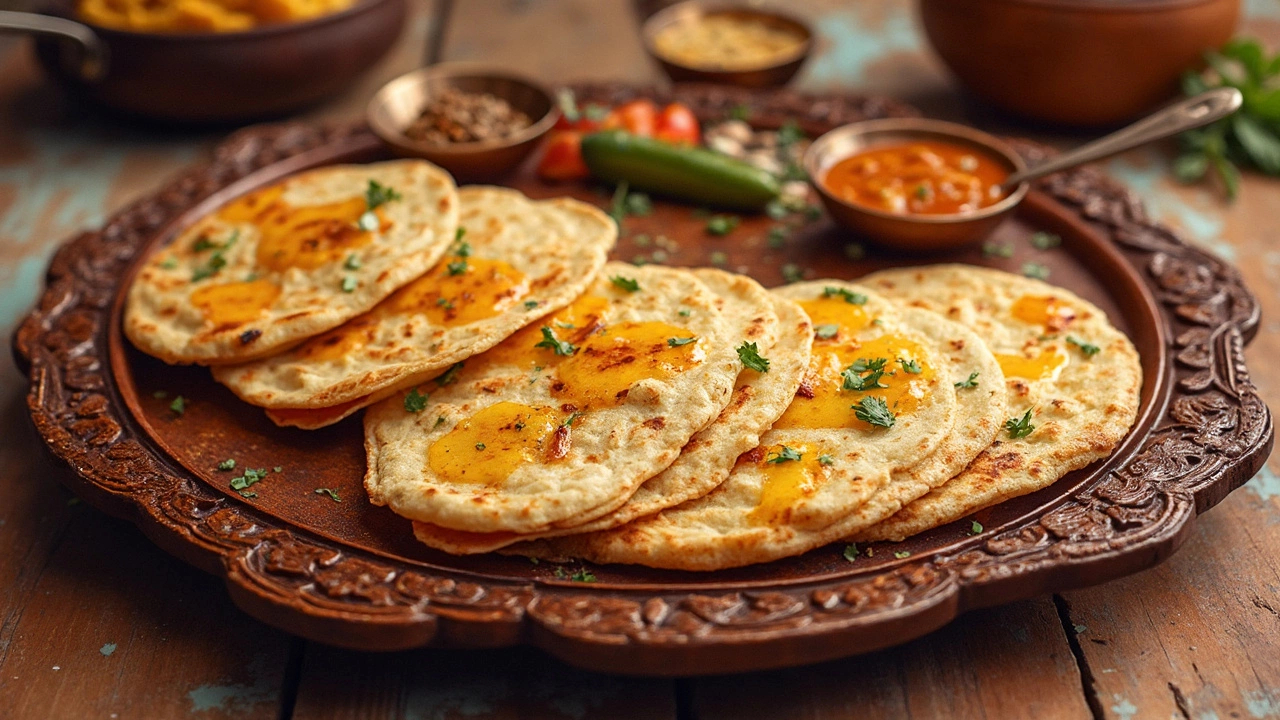How Cooking Methods Impact Calories in 1 Roti
 Feb, 16 2025
Feb, 16 2025
Ever wondered how much calories in 1 roti you're actually consuming? It's a common curiosity, especially for those who love this Indian bread but also care about their waistline. The calories in 1 roti mainly depend on how you prepare it. An average roti might contain about 70-80 calories. But the number can swing quite a bit based on your cooking method and additional toppings.
Let me tell you, the way you cook your roti matters. If you're using a traditional tawa to cook without any added fat, you're keeping it light. However, throw some ghee into the mix, and you get a more indulgent version. Now you're probably looking at about 20 extra calories per roti with ghee.
Pairing a roti with various sabzis is another story. Depending on the sabzi's ingredients and preparation, calories in 1 roti and sabzi can vary widely. But don't worry; there's a way to enjoy what you love without overdoing the calories. Knowing how to tweak your cooking methods can make a big difference, especially if you're trying to keep things balanced. Ready to dive deeper into how to enjoy your roti guilt-free?
- Basic Calorie Breakdown
- Cooking Techniques and Their Impact
- Adding Ghee: A Calorie Game Changer
- Pairing Roti with Sabzi
Basic Calorie Breakdown
So, you're thinking about calories in 1 roti and scratching your head, huh? It's simpler than it seems. A typical roti, made from whole wheat flour, water, and a pinch of salt, generally has about 70-80 calories. This number can vary slightly based on the size and thickness of your roti. But don't sweat it; we've got the details broken down for you.
Understanding the Ingredients
Roti is all about simplicity. Its main ingredient is whole wheat flour, which is a source of complex carbohydrates and some fiber. The amount of flour you use directly impacts the calorie count. Mix it with water and voilà, you have your dough. Here's a quick tip: opting for whole wheat can actually offer a bit more fiber compared to refined flour, keeping you fuller longer.
How Size and Thickness Play a Role
The size and thickness of your roti can also tweak the calorie numbers a bit. A large, thick roti will naturally have more calories than a smaller, thinner one. Want to keep that figure low? Aim for thinner rotis if you're watching your calorie intake.
| Factor | Calorie Impact |
|---|---|
| Size | More flour = More calories |
| Thickness | Thicker roti = More calories |
Cooking Oil and Its Impact
Traditional methods use minimal or no oil, which is perfect for keeping things light. How many calories in 1 roti can increase significantly if you're using oil liberally. A small brush of oil can add around 10-15 calories per side. If you’re trying to cut back, consider using a non-stick pan, or if you love that rich flavor, opt for healthier oils like olive oil.
So here you have it, the lowdown on how much calories in 1 roti really are and what influences that number. By keeping an eye on size, thickness, and the use of oil, you're in control. Sweet, right? Small tweaks, big impact!
Cooking Techniques and Their Impact
So, you're wondering how to change up your roti without blowing up your calorie count? The key lies in the cooking technique. Depending on the method you choose, calories in 1 roti can vary significantly. Let's break it down step-by-step.
Using a Tawa
If you're sticking with the classic tawa method, you're in luck! A plain roti made this way contains about 70-80 calories. It's the healthiest option because there's no oil or butter involved, just your dough and a heated surface.
Adding Ghee
Love that rich, buttery flavor? Brushing ghee on your roti is a simple way to get it. However, be aware that adding ghee can increase the calorie count by about 20 calories. Moderation is key if you're keeping an eye on how much calories in 1 roti with ghee you're consuming.
Baking or Grilling
For those exploring other methods, baking or grilling your roti can offer a different taste while keeping calories in check. Just remember not to overdo it with oil. A light spray or brush of oil can help prevent your roti from sticking while adding minimal extra calories.
Using Oil for Frying
Okay, let's chat about frying. This technique spikes up the calories pretty quickly, bringing one roti to a concerning 150-200 calories. It's delicious, sure, but maybe not the everyday approach if you're calorie-conscious!
Choosing the right method based on your dietary goals can make all the difference. Stick to healthier techniques, and enjoy your roti without worries!

Adding Ghee: A Calorie Game Changer
When it comes to enhancing the flavor of roti, many swear by ghee. It's a surefire way to make your meals tastier, but let's talk calories. Calories in 1 roti with ghee can be quite different from a plain one. When you add a single teaspoon of ghee, you're increasing your roti's calorie count by about 20-30 calories. Yeah, it makes a delicious difference, but it's an extra caloric punch you should be aware of.
The Joy of Ghee
Ghee is cherished for more than just its taste; it's packed with essential fatty acids, which can be good for your health in moderation. If you're counting calories but still want that buttery flavor, maybe you could try using less than a teaspoon. It's about finding balance.
- Moderation is Key: Use ghee sparingly. Even a small reduction can make a big difference over time.
- Choose Wisely: Opt for good quality organic ghee to reap potential health benefits.
- Add After Cooking: Drizzle ghee over roti once it's off the heat to preserve its nutrients and flavor.
Finding Your Sweet Spot
If you're asking how much calories in 1 roti is too much, it depends on your diet goals. The extra calories can add up quickly if ghee becomes a regular part of every meal. Here's a simple solution: try alternating days or meals when you use ghee, so you're not adding extra calories constantly.
If you're up for a bit of number-crunching, here's a calorie breakdown table for thought:
| Item | Calories |
|---|---|
| Plain Roti | 70-80 |
| Roti with 1 tsp Ghee | 90-110 |
So, next time you're about to make roti, think of how calories in 1 roti with ghee differ from a plain one. Small changes, like how much ghee to use, can make a significant impact on your daily intake.
Pairing Roti with Sabzi
Pairing your roti with sabzi not only makes for a delicious meal but also adds nutritional variety to your plate. However, if you're counting those calories, the kind of sabzi you choose can make a big difference. On average, a serving of sabzi can add anywhere from 50 to 150 calories, depending on the ingredients and cooking method.
If you're keen on keeping those numbers low, opt for sabzis made with non-starchy vegetables like spinach, cabbage, or cauliflower. These are nutrient-rich and generally lower in calories. On the other hand, sabzis with potatoes or paneer can add more calories, so it's good to keep an eye on portion sizes.
How to Make a Healthy Roti and Sabzi Combo
- Choose Your Roti Wisely: Stick to whole wheat for more fiber, and consider avoiding adding butter or ghee for fewer calories.
- Pick the Right Sabzi: Opt for veggies that are light and leafy over starchy ones. Use minimal oil and spices to retain the natural flavor without adding extra calories.
- Watch Portion Sizes: Serve moderate portions of both roti and sabzi to avoid going overboard.
- Balance the Meal: Add a side of salad or a cup of dal to round off your meal for added protein and fiber.
If you're craving a little indulgence, remember it's okay to treat yourself occasionally. Moderation is key. By being mindful of these choices, you can enjoy your calories in 1 roti and sabzi without the guilt. It's all about finding that sweet spot between health and taste.